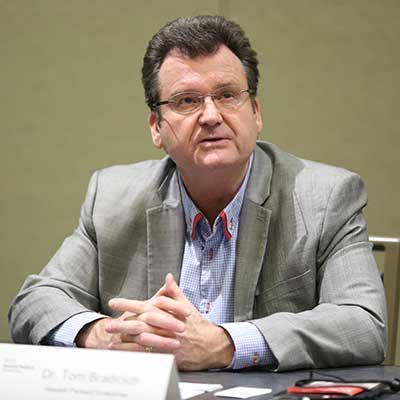CRN IoT Roundtable: 5 Ways Solution Providers Can Get Ahead Of The Game

Solution Provider Recipe For IoT Success
Solution providers have heard about how big the Internet of Things market will be, but what are the best practices, skill sets and products they need to build up their practices?
During an IoT roundtable hosted by CRN, executives from Hewlett Packard Enterprise, Cisco Systems and Forescout Technologies talked about how their partners can get ahead of the game. The roundtable, which took place during the XChange Solution Provider 2017 conference in March, included Tom Bradicich, vice president and general manager of servers, converged edge and IoT systems at HPE; Bryan Tantzen, general manager of Cisco's connected industry and manufacturing business unit; and Todd DeBell, vice president of worldwide channel sales at Forescout. Following are excerpts from the IoT roundtable.

Build Up Your Vertical Knowledge
Solution providers need to deepen their expertise around vertical markets, such as health care, manufacturing or transportation. Cisco's Tantzen said vendors rely on the channel for its expertise in customizing IoT products and bringing them to market as an end-to-end solution specifically tailored for niche customers.
"They've got to pick some verticals, hire some people that walk the talk, that can speak the language," he said. "The solutions are very similar. … It's still a switch, it's still a security firewall, it's just different protocols, different uses. But it's the same underlying technology. There's no reason they can't be very successful selling that technology into this new space. ... They just have to learn the language so they have basic credibility."

Create New Relationships
A new crop of vendors is emerging in the IoT space, including operational technology manufacturers like KMC Controls and lesser-known gateway and sensor companies like Lantronix. Cisco's Tantzen said that solution providers need to start looking at building new relationships around IoT solutions.
"[Partners] need to take the time to build new relationships," he said. "If you're only selling to the people over here that are doing the corporate network refresh, or the data center, and you're not talking to the OT buyer, you're not going to be successful."

Know The Market, Including Compliance And Regulations
One major challenge to IoT deployments in vertical markets – particularly health care and the public sector – is compliance. That's why solution providers with a deeper understanding of issues such as these will succeed in the market, according to Forescout's DeBell.
"I think the piece that is missing is that knowledge about -- like a gaming customer, someone who has casinos – what are the regulations from a state and federal standpoint? What other items are there? So, understanding the compliance piece, as well [is important]," he said. "And that's where I would take it a step further. Knowing the piece in the back end, from a channel partner perspective, how to put all the pieces together, is important."

Focus On Data Analytics
While connectivity will be a big part of IoT, the real recurring revenue opportunities will come from data monitoring and analysis, according to HPE's Bradicich.
"Why would you ever do this thing we call IoT? If you distill it, it's all about what action you'll take on the data from a thing," he said. "Now, the insight you get from the data when it's collected is done with analytics. You can't get the analytics running or any insight without some compute. So, the notion of connecting and then computing and then controlling and action, if you look at it, everything is a means to an end except the action. Everything's a means to an end."

Consider Acquiring Talent, New Skill Sets
Solution providers can pick from an array of companies to acquire to build up skills around app development, software development, security and connectivity needed for IoT.
"I've seen a couple [of solution providers], like WWT, buy software companies," Cisco's Tantzen said. "So that they can start doing software development into this OT space. That's something to think about as well."